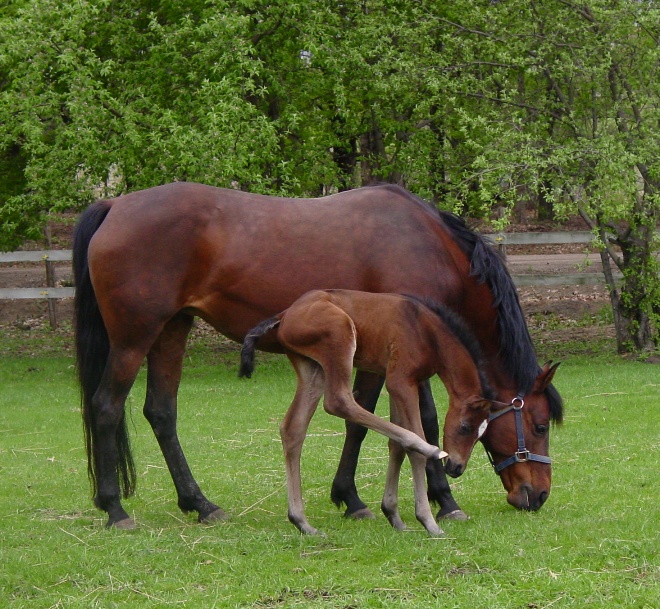Feeding the Broodmare During Lactation

Ferris with mom Rosie – foals exhibit the most entertaining behaviors….
Proper nutrition for the broodmare during lactation is essential to make certain that she produces adequate milk for the foal and also maintains her body condition so that she will re-breed successfully and safely carry the next year’s foal.
The broodmare has substantial increases in requirements for digestible energy, protein, lysine and minerals as she goes from the last month of gestation to the first month of lactation. For an 1100 lb mare, the following changes occur:
- Her DE requirement goes from 21.4 Mcal per day to 31.7 Mcal per day
- Her protein requirement goes from 630 grams to 1535 grams per day
- Her lysine requirement goes from 27.1 grams to 84.8 grams per day
- Her calcium requirement goes from 20 grams per day to 59.1 grams per day
- Similar increases occur in other amino acids and minerals, as well. They are documented in the Nutrient Requirements of Horses, Sixth Edition, pages 298-299.
If her feed intake is not increased to provide these nutrients, she will maintain milk product by using her body stores for energy, amino acids and minerals, causing loss of weight and loss of body condition as well as mineral losses.
To meet her increased DE requirement, an additional 7.5 pounds of grain containing 1364 Calories/lb will need to be added to her diet gradually post foaling. Fortunately, she also can consume more dry matter during lactation, so she is actually able to eat more forage and more feed. If she is fed a product suitable for lactating mares, the additional feed will provide the additional energy as well as the other important nutrients. She will also require unlimited access to water and salt free choice along with good quality forage.
If she continues to lose weight, she is much less likely to cycle normally during lactation and less likely to become pregnant and carry the next foal. This may be why some mares are “every other year” mares in producing foals. They are frequently mares that produce large foals and milk very heavy during lactation. As a result, they do not maintain body condition and do not re-breed and carry a foal the next year. When they are not in foal and not lactating, they gain weight and come back into the next breeding season in good flesh and breed successfully. This is even more likely if they are not in a suitable body condition (BCS 6+) prior to foaling.
The nutrient requirements of the mare will start to decrease at the 3rd month of lactation and will gradually decrease until the foal is weaned. Monitoring body condition of the mare and the foal is one of the best ways to determine if the feeding program for both is producing the desired results!
